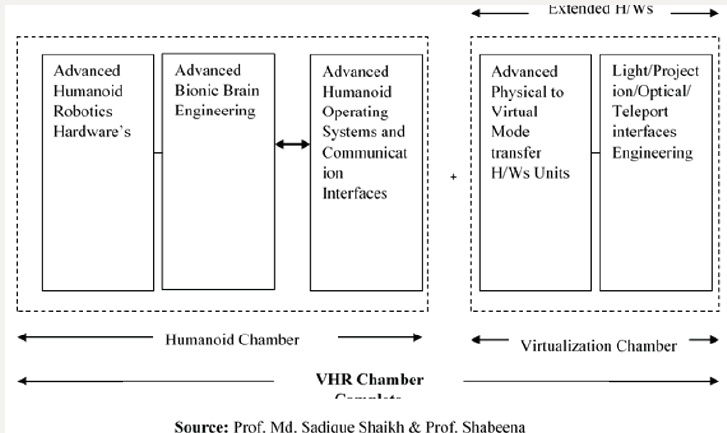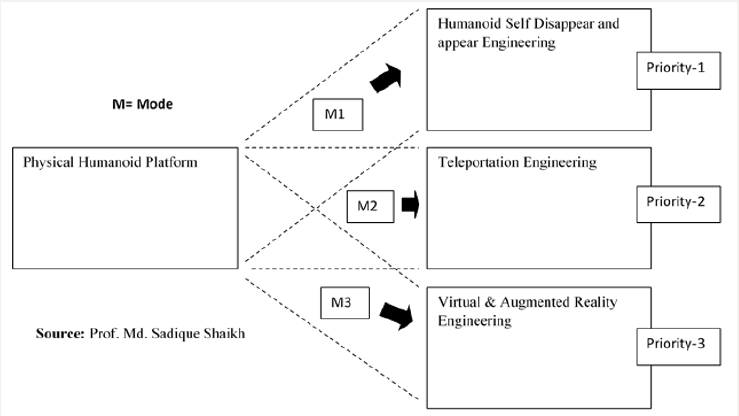
Lupine Publishers Group
Lupine Publishers
Menu
ISSN: 2643-6736
Short Communication(ISSN: 2643-6736) 
Insight Virtual Humanoid Robotics Modeling: the Ultimate Level 0f Artificial Intelligence Volume 1 - Issue 1
Sadique Shaikh1* and Shabeena Khan2
- 1Department of Institute of Management & Science Bhusawal, India
- 2Department of Computer Science, Poona College, India
Received: September 21, 2018; Published: September 25, 2018
*Corresponding author: Sadique Shaikh, Department of Institute of Management & Science, Bhusawal, India
DOI: 10.32474/ARME.2018.01.000105
Abstract
I have no doubt to state Virtual Humanoid Robots (VHRs) are the ultimate level of Artificial Intelligence which change the scenario of world and human technologies, it would be applicable in all domains of technology with common factor Ultra Artificial Intelligence (UAI) with disappear and appear ability by any means which boost to our civilization from Type-0 to type-1 civilization at least and would be first step to compete with Aliens technology, if exist (hypothesis only). I would like to define term Virtual Humanoid Robotics (VHR) as “it’s Humanoid Robotics with UAI and has ability to transform from Physical to Virtual by any Internal (Humanoid Self-Control) or External (Human-Control) mode activation mechanism”. VHR is future technology which will use energy from Sun (or Space), Internet of Things (IoT) with RFID USN, Bigdata and Self-learning and healing mechanism. Now I would like to generate future utopia front of your eyes with initial modeling to coined term VHR in this short communication.
Keywords: Humanoid Robotics; Bionic Brain; UAI; Virtual Humanoid Robotics; Robotics Teleportation
Modeling to VHR
a) VHR-Basic Engineering Model
I depicted in my first model “VHR-Basic Engineering” that there we need to extent our fundamental engineering aspect of Humanoid to Virtual Humanoid robotics domain. Hence model divided into two broad chambers as Humanoid Chamber and to give virtual ability Virtualization chamber. As we can analyze from model for successful humanoid building we need advanced Humanoid robotics hardware’s which link to Bionic Brain as similar to human brain mimic in the form of UAI which further cascade to Advanced Humanoid Operating System and Communication Interfaces. After successful engineering of first segment successful physical humanoid can build but to next level i.e. to convert physical humanoid into virtual and back from virtual to physical we doesn’t need to modify hardware but to strongly need to give extension to existed. Hence Virtualization chamber exhibits this regard in model. The virtualization chamber has two functional blocks to engineer Advanced Physical to Virtual Mode transfer Units and Light/Projection/Optical/Teleport interfaces Engineering (Figure 1).
b) Physical-to-Virtual Modes Switch Model
My second purposed model “Physical-to-Virtual Mode Switch” model one of the essential VHR engineering models, in another word can say expansion and detail discussion on Virtualization Chamber second part of my first model. Its lucid and clear representation of concept in model diagram I considered three different possible modes viz. M1, M2 and M3 which may be increase in future with technological advancement and new methods of virtualization. The mode M1 has highest priority to implement VHR where Humanoid hardware itself has ability to appear and disappear itself with selfcontrol (Internal Control) which is only hypothesis right now. The second mode M2 has possible and second priority Teleportation and lot research going on this Mode M2 by several premium university and institutions scholars. The last mode M3 is easiest one but not satisfactory where virtualization engineer using virtual and augmented reality [1-10] (Figure 2).
Conclusion
I have discussed two models and with the help of them try to learn one of the promising and world change future technology “Virtual Humanoid Robotics” where Humanoid not only seems to be like human in near future but also will have ability to Avatar itself. This would be very helpful to send humanoid virtually in deepspace, on stars and planets to understand universe closely with teleportation or internal humanoid mechanism. VHR also ultimate level of AI hence might be shift mankind race on planet earth from Type-0 civilization to Type-1 civilization as shown in sci-fi movies.
References
- Sadique Shaikh (2013) Analysis and modeling of Strong A.I to engineer BIONIC brain for humanoid robotics application. American Journal of Embedded System and Applications, Published by Science Publishing Group 1(2): 27-36.
- Sadique Shaikh (2017) Ultra Artificial Intelligence (UAI): Redefing AI fir New Research Dimension” in Advanced Robotics & Automation (ARA), OMICS International, London 6(2): 163.
- Sadique Shaikh (2017) Fundamental Engineering for Brain-Computer Interfacing (BCI): Initiative for Neuron-Command Operating Devices. Computational Biology and Bioinformatics (CBB), SciencePG, U.S.A, November 5(4): 50-56.
- Sadique Shaikh (2018) Defining ultra artificial intelligence (UAI) implementation using bionic (biological-like-electronics) brain engineering insight. MOJ App Bio Biomech 2(2): 127-128.
- Sadique Shaikh (2018) Insight Artificial to Cyborg Intelligence Modeling. Arch Ind Engg 1(1): 1- 5.
- Sadique Shaikh (2018) Artificial Intelligence Engineering for Cyborg Technology Implementation” in Robotics & Automation Engineering Journal , Robot Autom Eng J 3(1).
- (2018) Engineering Insight for Humanoid Robotics Emotions and Violence with Reference to System Error 1378. Robot Autom Eng J USA 3(2).
- (2018) Defining Cyborg Intelligence for Medical and Super-Human Domains” in Trends in Technical & Scientific Research 2(3).
- (2018) Ultra artificial intelligence (UAI) engineering for robotics violence control, detect and corrective measures. International Robotics & Automation Journal, Int Rob Auto J 4(4): 242-243.
- Sadique S, Shabeena K (2018) Introducing DeepMind Learning Modeling. Adv Rob Mec Eng 1(1).

Top Editors
-

Mark E Smith
Bio chemistry
University of Texas Medical Branch, USA -

Lawrence A Presley
Department of Criminal Justice
Liberty University, USA -

Thomas W Miller
Department of Psychiatry
University of Kentucky, USA -

Gjumrakch Aliev
Department of Medicine
Gally International Biomedical Research & Consulting LLC, USA -

Christopher Bryant
Department of Urbanisation and Agricultural
Montreal university, USA -

Robert William Frare
Oral & Maxillofacial Pathology
New York University, USA -

Rudolph Modesto Navari
Gastroenterology and Hepatology
University of Alabama, UK -

Andrew Hague
Department of Medicine
Universities of Bradford, UK -

George Gregory Buttigieg
Maltese College of Obstetrics and Gynaecology, Europe -

Chen-Hsiung Yeh
Oncology
Circulogene Theranostics, England -
.png)
Emilio Bucio-Carrillo
Radiation Chemistry
National University of Mexico, USA -
.jpg)
Casey J Grenier
Analytical Chemistry
Wentworth Institute of Technology, USA -
Hany Atalah
Minimally Invasive Surgery
Mercer University school of Medicine, USA -

Abu-Hussein Muhamad
Pediatric Dentistry
University of Athens , Greece

The annual scholar awards from Lupine Publishers honor a selected number Read More...















